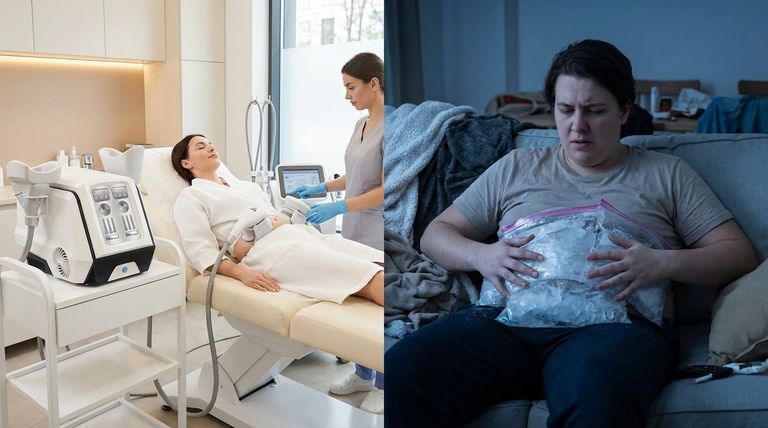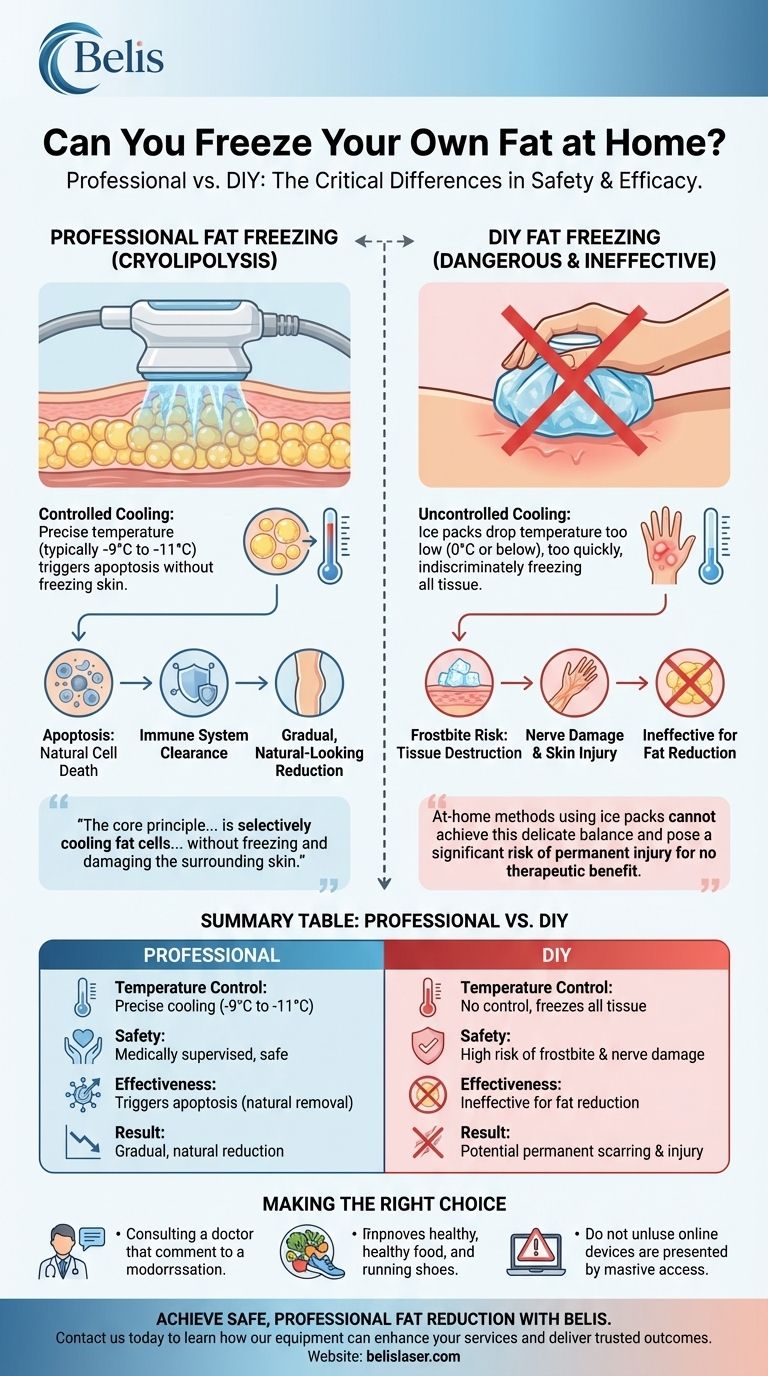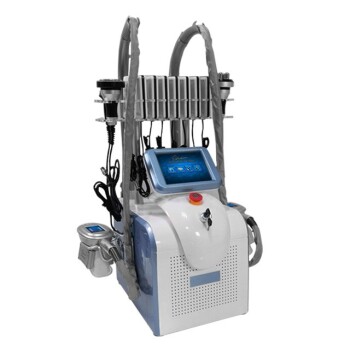In short, you should not attempt to freeze your own fat at home. While professional medical treatments do use cold to eliminate fat cells, DIY methods lack the precise temperature control and critical safety features required for the procedure. Attempting this at home is far more likely to cause severe skin damage, like frostbite, than it is to reduce fat.
The core principle of medical fat freezing is selectively cooling fat cells to a temperature that triggers their natural death without freezing and damaging the surrounding skin. At-home methods using ice packs cannot achieve this delicate balance and pose a significant risk of permanent injury for no therapeutic benefit.

How Professional Fat Freezing (Cryolipolysis) Actually Works
To understand why a DIY approach is so dangerous, you must first understand the science behind a professional, medically supervised procedure like CoolSculpting. It is a highly controlled and specific process.
The Principle of Controlled Cooling
The entire procedure is based on a key biological fact: fat cells freeze at a higher temperature than skin cells. Skin is composed mostly of water, which freezes at 0°C (32°F), whereas the lipids inside fat cells begin to crystallize at warmer temperatures.
Medical cryolipolysis exploits this difference. A device precisely lowers the temperature of a targeted area to a point that is cold enough to trigger fat cell death but warm enough to leave skin, nerves, and muscle unharmed.
The Importance of a Precise Temperature
Professional devices cool subcutaneous fat to a specific and constant temperature, typically between -9°C and -11°C, for a sustained period. This is the "sweet spot" that initiates a process called apoptosis, or programmed cell death, in the fat cells.
Apoptosis: A Natural Removal Process
Apoptosis is the body's safe and gradual way of clearing out damaged cells. Over the weeks and months following a treatment, your immune system identifies these crystallized, dying fat cells and slowly removes them as waste. This is not an immediate effect; it is a slow, natural-looking reduction.
The Dangers of DIY Fat Freezing
Using ice, ice packs, or other home methods bypasses every safety and efficacy principle of medical cryolipolysis. It is a fundamentally different and dangerous activity.
Uncontrolled and Uneven Cooling
An ice pack is designed for one purpose: to make tissue as cold as possible, as fast as possible. It offers zero temperature control. The surface of your skin will quickly drop to 0°C or below, leading to indiscriminate freezing of all tissue.
The High Risk of Frostbite
When your skin and the underlying tissue freeze, it's called frostbite. This is not targeted fat reduction; it is uncontrolled tissue destruction. Ice applied directly to the skin can cause severe frostbite in minutes.
The resulting damage can include blistering, painful ulcers, permanent changes in skin pigmentation, and deep scarring.
Potential for Permanent Nerve Damage
Nerves are also highly susceptible to cold injury. The uncontrolled freezing from a DIY attempt can damage superficial nerves, leading to long-term or even permanent numbness, tingling, or chronic pain (post-traumatic neuralgia) in the affected area.
Ineffectiveness for Fat Reduction
Even if you were to avoid severe injury, a DIY attempt would fail to reduce fat. The cooling is too superficial, too uneven, and not sustained at the precise temperature needed to trigger apoptosis in a meaningful number of fat cells. You would be risking permanent skin damage for no result.
Understanding the Trade-offs: Professional vs. DIY
The desire for a low-cost alternative is understandable, but the comparison between a medical procedure and a home attempt is a false one.
Cost vs. Safety
Professional cryolipolysis is an investment in a procedure that has been clinically studied for safety and efficacy. The cost covers the sophisticated technology, safety mechanisms (like gel pads and temperature sensors), and the expertise of a trained professional who can ensure it's done correctly.
A DIY attempt trades this safety and efficacy for the high probability of injury, which may lead to much higher medical costs to treat the resulting damage.
Predictable Results vs. Unpredictable Harm
While results can vary, a professional treatment offers a predictable range of outcomes based on extensive clinical data. The outcome of a DIY attempt is completely unpredictable but leans heavily toward injury, not improvement. You are not performing a "cheaper version" of the same treatment; you are simply giving yourself frostbite.
Making the Right Choice for Your Goal
Achieving your body contouring goals requires a safe and effective strategy. Bypassing medical science in favor of dangerous home methods is not a viable path.
- If your primary focus is non-invasive fat reduction: Consult with a board-certified dermatologist or plastic surgeon. They can confirm if you are a good candidate for a procedure like CoolSculpting and perform it safely.
- If your budget is the main concern: Focus on the proven, foundational methods of diet and exercise. These strategies are the safest and most reliable way to manage body composition and overall health.
- If you see "at-home fat freezing" devices for sale: Be extremely skeptical. These unregulated products lack the cooling power and safety controls of medical devices and cannot replicate their results.
Ultimately, protecting your body from harm must be the top priority in any aesthetic pursuit.
Summary Table:
| Aspect | Professional Cryolipolysis | DIY Fat Freezing |
|---|---|---|
| Temperature Control | Precise cooling (-9°C to -11°C) | No control, freezes all tissue |
| Safety | Medically supervised, safe for skin | High risk of frostbite and nerve damage |
| Effectiveness | Triggers fat cell apoptosis (natural removal) | Ineffective for fat reduction |
| Result | Gradual, natural-looking fat reduction | Potential for permanent scarring and injury |
Achieve Safe, Professional Fat Reduction with BELIS
Don't risk your health with dangerous DIY methods. BELIS specializes in professional medical aesthetic equipment, providing safe and effective cryolipolysis technology for medical aesthetics clinics and premium beauty salons. Our advanced devices ensure precise temperature control and proven results, protecting your clients from harm.
Contact us today to learn how our equipment can enhance your services and deliver trusted outcomes.
Visual Guide

Related Products
- Fat Freezing Cryolipolysis Machine for Body Contouring
- Cryolipolysis Fat Freezing Machine and Ultrasonic Cavitation Device
- Cryolipolysis Fat Freezing Machine Ultrasonic Cavitation Fat Reducing Device
- Fat Freezing Cryolipolysis Machine for Body Contouring
- Cryolipolysis Fat Freezing Machine with Cavitation and Laser Lipolysis
People Also Ask
- How does fat leave the body after fat freezing? The Science of Permanent Fat Cell Removal
- Are there any risks with fat freezing? A guide to understanding cryolipolysis side effects
- What are the negatives of fat freezing? Understanding the Risks and Side Effects
- Do fat freezing machines work? A Realistic Guide to Body Contouring Results
- How long do fat freezing results last? Permanently Remove Stubborn Fat Cells



















